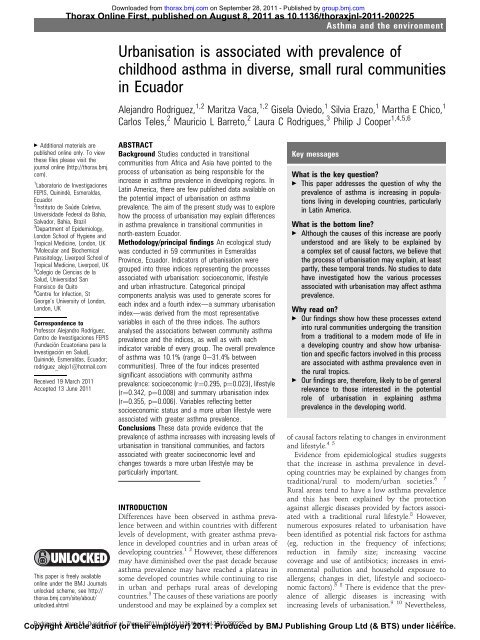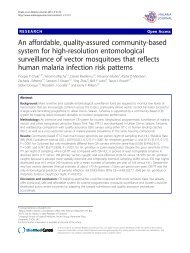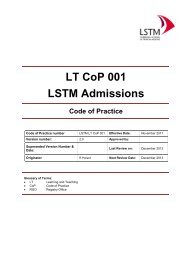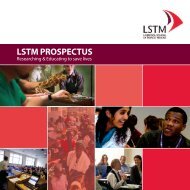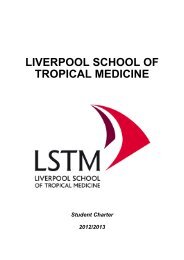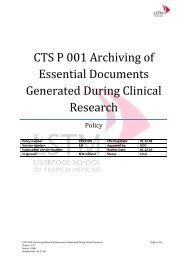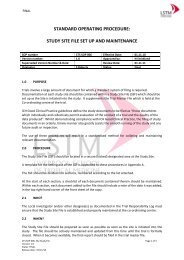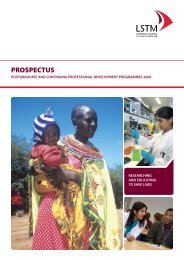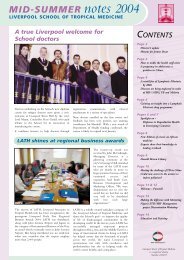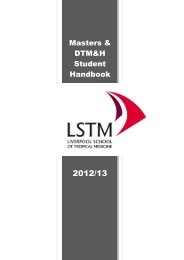Download (130kB) - LSTM Online Archive - Liverpool School of ...
Download (130kB) - LSTM Online Archive - Liverpool School of ...
Download (130kB) - LSTM Online Archive - Liverpool School of ...
You also want an ePaper? Increase the reach of your titles
YUMPU automatically turns print PDFs into web optimized ePapers that Google loves.
<strong>Download</strong>ed from thorax.bmj.com on September 28, 2011 - Published by group.bmj.comAsthma and the environmentFigure 1 Scatter plots <strong>of</strong> therelationships between communityasthma prevalence (measured by theproportion <strong>of</strong> children with wheezing inthe last 12 months) and z scores for thefirst components <strong>of</strong> infrastructure (A),socioeconomic (B), lifestyle (C) andsummary urbanisation (D) indices. Theregression line is shown for eachrelationship. Red squares representoutliers and extreme observationsidentified on residual analysis inbivariate linear regression.activity (b¼0.065) and having a household cat (b¼0.091). In themultivariate analysis, 5/10 lifestyle indicators remained in thefinal model, explaining 19.8% <strong>of</strong> variability in asthma prevalence(adjusted R 2 ¼0.198; p¼0.005), <strong>of</strong> which consumption <strong>of</strong> fizzydrinks was statistically significant (b¼0.132).DISCUSSIONIn the present study, we conducted an ecological analysis tounderstand better if urbanisation (and specific factors associatedwith this process) may explain the variation in asthma prevalencebetween rural transitional communities. Clearly, urbanisationis a highly complex process and is strongly associatedwith other aspects <strong>of</strong> modernisation, especially in developingcountries. We chose to measure urbanisation by exploring variablesrepresentative <strong>of</strong> infrastructure, socioeconomic and lifestyleindicators that together constitute much <strong>of</strong> what isunderstood by urbanisation. A population does not have to livein an urban environment to experience many <strong>of</strong> the processesassociated with urbanisation and the effects <strong>of</strong> individual factorsthat constitute urbanisation on asthma prevalence may be moreclearly measured in transitional societies where there is likely tobe sufficient heterogeneity in exposure to such factors.Cross-sectional studies conducted in developing countrieshave shown a higher prevalence <strong>of</strong> asthma reported in urbancompared with rural populations, although the magnitude <strong>of</strong>the difference is variable: South Africa (urban¼33.0%, periurban¼34.4%;rural¼17.0%), Zimbabwe (urban rich¼5.8%;urban poor¼3.1%; rural¼0.1%), Ethiopia (urban¼3.6%,rural¼1.6%), Ghana (urban rich¼4.7%, urban poor¼2.2%,rural¼1.4%), Kenya (urban¼22.9%, rural¼13.2%) and SaudiArabia (urban¼14.9%, rural¼5.4%). 21e26 Similarly, crosssectionalstudies conducted at different times have providedevidence for temporal increases in the prevalence <strong>of</strong> asthma inboth urban and rural populations, 27 28 although the urbaneruraldifference in asthma prevalence may be narrowing. 10 29 Previousecological studies have compared asthma prevalence betweencities 20 within a country or between countries represented byone or more cities. 2 Inter-country comparisons such as theInternational Study <strong>of</strong> Asthma and Allergies in Childhood 2 areunlikely to provide useful insights into the effects <strong>of</strong> urbanisationon asthma prevalence given that most study centres were incities and different countries are likely to have different experiences<strong>of</strong> the individual urbanisation processes. Intra-countrycomparisons may be more useful: an ecological comparisonbetween several cities in Brazil found that asthma prevalencewas greater in cities with more poverty and inequality. 20The present study, which compared small rural communities,had significant heterogeneity in the levels <strong>of</strong> exposure to theTable 3IndicesAssociations between community asthma prevalence and urbanisation indicesAsthma prevalence Infrastructure Socioeconomic Lifestyler p r p r p r pInfrastructure 0.173 0.190 1 e e e e eSocioeconomic 0.295 0.023 0.757
Asthma and the environment<strong>Download</strong>ed from thorax.bmj.com on September 28, 2011 - Published by group.bmj.comTable 4GroupsAssociations between community asthma prevalence and individual indicators <strong>of</strong> infrastructure, socioeconomic and lifestyle indicesBivariate analysesMultivariate analysesIndicatorsb p b CI (95%) pInfrastructure Administrative grade (parish) 0.017 0.989Spatial organisation(a) Disperse (reference) e e(b) Blocks 0.147 0.919(c) Neighbourhood 0.615 0.712Transport access (road) 1.377 0.263 6.059 9.313 to 2.805 15 1.994 0.390 5.065 0.168 to 9.961 0.043Socioeconomic Father’s education 0.072 0.19Mother’s education 0.023 0.62 0.074 0.193 to 0.046 0.221Household income 0.072 0.077 0.099 0.11 to 0.208 0.078Access to electricity 0.029 0.077 0.045 0.005 to 0.084 0.028Material goods 0.104 0.05Cement house 0.009 0.865 0.127 0.247 to 0.008 0.037Gas for cooking 0.046 0.019Motor vehicles 0.164 0.012 0.168 0.043 to 0.294 0.009Uncrowded household 0.053 0.235Lifestyle Hamburger consumption 0.104 0.015 0.076 0.025 to 0.176 0.137Fizzy drink consumption 0.121 0.004 0.132 0.041 to 0.223 0.005No physical exercise 0.064 0.12 0.069 0.012 to 0.149 0.093Television in house 0.034 0.111 0.034 0.088 to 0.020 0.214TV viewing 0.048 0.046No farming activities 0.065 0.05Cat in house 0.091 0.025 0.049 0.035 to 0.133 0.248Dog in house 0.050 0.191Migration 0.061 0.22Parasite infection rate 0.009 0.777Results shown are for bivariate and multivariate linear regression analyses.urbanisation indicators between communities and was able tomeasure the potential effects <strong>of</strong> these indicators on asthmaprevalence. The study was able to demonstrate that lifestyleindicators and socioeconomic indicators had stronger overalleffects on asthma prevalence than infrastructure indicators(figure 1), indicating that a higher asthma prevalence waspresent in communities with a higher socioeconomic level anda more urbanised lifestyle. Indeed, asthma prevalence increasedwith increasing household income, access to electricity, materialgoods, gas for cooking and possession <strong>of</strong> motor vehicles. Ourfindings are consistent with the findings <strong>of</strong> other studiesconducted in transitional communities that have shown anassociation between better socioeconomic status and asthmaprevalence (ie, urban rich vs urban poor). 22 24 Rural residence hasbeen repeatedly shown to be protective against allergic diseasesand this effect has been attributed to farming exposures. 8Consistent with these, communities with a higher percentage <strong>of</strong>households not involved in agricultural activities had a higherprevalence <strong>of</strong> asthma. Rates <strong>of</strong> parasite infection with geohelminthinfections were not associated with asthma prevalence inour study population in agreement with the findings <strong>of</strong> previousstudies. 11 30 The increased consumption <strong>of</strong> fast foods such ashamburgers and s<strong>of</strong>t drinks (that represent new food habits)was associated with greater asthma prevalence and is consistentwith individual-level studies that have shown changes in diet <strong>of</strong>populations undergoing transition is associated with an increasein asthma. 31 32 Factors associated with a sedentary lifestyle suchas limited physical activity and watching TV for more than 1 hdaily were associated with greater asthma prevalence, and areconsistent with the findings <strong>of</strong> previous studies. 33 34 Somewhatparadoxically, ownership <strong>of</strong> motorised vehicles was associatedwith an increased asthma prevalence but road access witha decreased asthma prevalence. Road access does not necessarilymean a higher level <strong>of</strong> urbanisation than river access becausemost roads are dirt tracks with limited public transportation andaccessible communities have few privately-owned vehicles.Communities with river access actually had higher levels<strong>of</strong> ownership <strong>of</strong> motor vehicles (motorised canoes), and suchownership could be associated, for example, with greaterlevels <strong>of</strong> environmental pollution with exhaust particulates,a potential mechanism mediating an increase in asthma.The lifestyle index that showed the strongest association withthe prevalence <strong>of</strong> asthma was also strongly associated with theother urbanisation indices. These relationships suggest that thegrowing influence <strong>of</strong> urban lifestyle on rural societies mayexplain at least partly the increase in asthma prevalence in rural6 <strong>of</strong> 8 Rodriguez A, Vaca M, Oviedo G, et al. Thorax (2011). doi:10.1136/thoraxjnl-2011-200225
<strong>Download</strong>ed from thorax.bmj.com on September 28, 2011 - Published by group.bmj.comAsthma and the environmentpopulations and the declining gap between urban and ruralasthma prevalence. This is illustrated in the present study by thehigh rates <strong>of</strong> television viewing, consumption <strong>of</strong> s<strong>of</strong>t drinks andpresence <strong>of</strong> material goods in some <strong>of</strong> the communities. Theweak associations between the infrastructure index (and mostindicators that constituted this index) with asthma prevalencemight be related to the fact that in communities undergoingtransition in developing countries some elements <strong>of</strong> the urbanisationprocess develop less faster than others changes (eg, socialand consumption changes). 13 For example, a high proportion <strong>of</strong>communities lacked basic services but had a high percentage <strong>of</strong>television ownership. The implementation <strong>of</strong> basic infrastructureand basic services tends to lag behind other urbanisationprocesses because <strong>of</strong> a lack <strong>of</strong> economic resources from highlycentralised political establishments that are reluctant to investin populations that do not represent their primary politicalconstituencies. The disparities in the levels <strong>of</strong> urbanisation indeveloping countries could help explain the variation <strong>of</strong> asthmaprevalence between and within countries <strong>of</strong> Latin America.Our study findings from an ecological analysis are subject tosome limitations. First, the associations observed at thecommunity level may not reflect associations at the individuallevel (ecological fallacy). Despite the fact that we collecteddetailed information on urbanisation indicators, other data thatare likely to be important (eg, environmental sampling for airpollution) were not available. Smoking was not included in ouranalysis because in the study area, a widespread traditionallifestyle habit is to smoke a traditional cigarette, ‘cachimba’, andthus smoking in the context <strong>of</strong> this study, given that we did notcollect data to distinguish smoking <strong>of</strong> traditional versus moderncigarettes, is unlikely to be a useful explanatory variable forurbanisation. We defined asthma as having a wheeze in theprevious 12 months. This is a widely used definition and has theadvantage <strong>of</strong> simplicity, but <strong>of</strong> course not all wheezing isasthma. However, we believe that this definition is likely to beless subject to misclassification compared with other definitions(such as doctor diagnosis <strong>of</strong> asthma) used in rural populationswith limited access to healthcare. Our analysis is limited indegree to which we can attribute urbanisation as being a causalfactor for asthma prevalencedmany <strong>of</strong> the variables included inour analysis are markers <strong>of</strong> lifestyle and while being associatedwith asthma prevalence may not necessarily be causal.In conclusion, we have explored the effects <strong>of</strong> factors associatedwith urbanisation on the community prevalence <strong>of</strong> asthmain rural transitional communities in a developing country.Clearly, urbanisation is a complex process that comprises anarray <strong>of</strong> changes that modify the living environment and humanbehaviours. The consequence <strong>of</strong> such changes that penetrateinexorably over time into rural environments may be to depriveurbanising populations <strong>of</strong> childhood exposures that are importantfor the development <strong>of</strong> normal airway function. Our dataprovide evidence that the process <strong>of</strong> urbanisation is associatedwith a greater prevalence <strong>of</strong> asthma in rural communities inEcuador. The high level <strong>of</strong> socioeconomic inequality and therapid but variable rate <strong>of</strong> urbanisation occurring in LatinAmerica may explain temporal trends and differences in asthmaprevalence in this region. 35 To explore these findings better,future studies should pay attention to the social mechanismsand processes that modify the rural way <strong>of</strong> life towards an urbanlifestyle.Acknowledgements The Ecuadorian Elimination Programme for Onchocerciasis(Dr Eduardo Gomez, Dra. Raquel Lovato, Lcda. Margarita Padilla, Lcda Anabel Ponce,Lcda Ing Sandra Barrera, Magdalena Cortez) and CECOMET (Dr Gregorio Montalvoand Lcda Monica Marquez) are thanked for support in visiting communities andproviding community censuses. The health promoters, school teachers, parents andchildren are thanked for their enthusiastic cooperation. The study forms part <strong>of</strong> theSCAALA (Social Changes, Asthma, and Allergies in Latin America) programme <strong>of</strong>research.Funding Wellcome Trust, UK, HCPC Latin American Centres <strong>of</strong> Excellence Programme(ref 072405/Z/03/Z). The funders had no role in study design, data collection andanalysis, decision to publish or preparation <strong>of</strong> the manuscript.Competing interests None.Ethics approval The study protocol was approved by the ethics committee <strong>of</strong> theHospital Pedro Vicente Maldonado, Ecuador.Contributors Study design: PJC, AR, MC, LCR, MLB. Data collection; AR, MV, GO,SE. Data analysis: AR,CT. Draft manuscript: AR, PJC. Manuscript review: AR, PJC, LR,MLB.Provenance and peer review Not commissioned; externally peer reviewed.REFERENCES1. Woolcock AJ, Peat JK. Evidence for the increase in asthma worldwide. Ciba FoundSymp 1997;206:122e34.2. Anon. Worldwide variation in prevalence <strong>of</strong> symptoms <strong>of</strong> asthma, allergicrhinoconjunctivitid, and atopic eczema: ISSAC. The international Study <strong>of</strong> Asthma andAllergies in Childhood ISAAC. Lancet 1998;351:1225e32.3. Pearce N, Ait-Khaled N, Beasley R, et al. Worldwide trends in the prevalence <strong>of</strong>asthma symptoms: phase three <strong>of</strong> the International Study <strong>of</strong> Asthma and Allergies inChildhood (ISAAC). Thorax 2007;62:758e66.4. Beasley R, Crane J, Lai CK, et al. Prevalence and etiology <strong>of</strong> asthma. J Allergy ClinImmunol 2000;105:S466e72.5. Von Hertzen L, Haahtela T. Asthma and atopydthe price <strong>of</strong> affluence? Allergy2004;59:124e37.6. Weinberg EG. Urbanization and childhood asthma: an African perspective. AllergyClin Inmunol 2000;105:224e31.7. Singh M. The burden <strong>of</strong> asthma in children. An Asian perspective. Paediatr RespirRev 2005;6:14e19.8. Von Hertzen L, Haahtela T. Disconnection <strong>of</strong> man and the soil: reason for theasthma and atopic epidemic? Allergy 2006;117:334e44.9. Nicolaou N, Siddique N, Custovic A. Allergic disease in urban and rural populations:increasing prevalence with increasing urbanization. Allergy 2005;60:1359e60.10. Viinanen A, Munhbayarlah S, Narantsetseg L, et al. Prevalence <strong>of</strong> asthma, allergicrhinocongunctivitis and allergic sensitisation in Mongolia. Allergy 2005;60:1370e77.11. Cooper PJ, Rodrigues LC, Cruz AA, et al. Asthma in Latin America: a public healthchallenge and research opportunity. Allergy 2009;64:5e17.12. Fischer GB, Camargos PAM, Mocelin HT. The burden <strong>of</strong> asthma in children: a LatinAmerican perspective. Pediatr Respir Rev 2005;6:8e13.13. Germani G. El proceso de urbanización en los países avanzados y en los países endesarrollo. In: Germani G, ed. Sociología de la Modernización. Buenos Aires: PAIDOSPress, 1971:146e76.14. Caicedo CM. Documento de Diagnóstico del Área de Salud # 7 Borbón. Cantón EloyAlfaro provincia de Esmeraldas, 2004.15. Cooper PJ, Chico ME, Rodriguez A, et al. Risk factors for asthma and allergyassociated with urban migration: background and methodology <strong>of</strong> a cross-sectionalstudy in Afro-Ecuadorian school children in Northeastern Ecuador (Esmeraldas-SCAALA Study). BMC Pulm Med 2006;6:24e31.16. Weiland SK, Bjorksten B, Brunekreef B, et al. Phase II <strong>of</strong> the International Study <strong>of</strong>Asthma and Allergies in Childhood (ISAAC II): rationale and methods. Eur Respir J2004;24:406e12.17. Maroco J. Análise de Componentes Principais. In: Maroco J, ed. AnáliseEstatisticadCom utilização do SPSS. Lisboa: Silabo Press, 2003:231e57.18. Meulman J. Optimal Scaling Methods for Multivariate Categorical Data Analysis.Leiden: Leiden University, 2000.19. Hair JF, Anderson RE, Tathan RL, et al. Análise factorial. In Análise Multivariada dedados. Porto Alegre: Bookman Press, 2005:88e130.20. Cunha SS, Pujades MR, Barreto ML, et al. Ecological study <strong>of</strong> socio-economicindicators and prevalence <strong>of</strong> asthma in schoolchildren in urban Brazil. BMC PublicHealth 2007;7:205.21. Steinman HA, Donson H, Kawalski M, et al. Bronchial hyper-responsiveness andatopy in urban, peri-urban and rural South African Children. Pediatr Allergy Immunol2003;14:383e93.22. Keeley DJ, Neill P, Gallivan S. Comparison <strong>of</strong> the prevalence <strong>of</strong> reversible airwaysobstruction in rural and urban Zimbabwean children. Thorax 1991;46:549e53.23. Yemaneberhan H, Bekele Z, Venn A, et al. Prevalence <strong>of</strong> wheeze and asthma andrelation to atopy in urban and rural Ethiopia. Lancet 1997;350:85e90.24. Addo Yobo EO, Custovic A, Taggart SC, et al. Exercise induced bronchospasm inGhana: differences in prevalence between urban and rural schoolchildren. Thorax1997;52:161e5.25. Ng’ang’a LW, Odhiambo JA, Mungai MW, et al. Prevalence <strong>of</strong> exercise inducedbronchospasm in Kenyan school children: an urban-rural comparison. Thorax1998;53:919e26.26. Hijazi N, Abalkhail B, Seaton A. Asthma and respiratory symptoms in urban and ruralSaudi Arabia. Eur Respir 1998;12:41e4.Rodriguez A, Vaca M, Oviedo G, et al. Thorax (2011). doi:10.1136/thoraxjnl-2011-200225 7 <strong>of</strong> 8
Asthma and the environment<strong>Download</strong>ed from thorax.bmj.com on September 28, 2011 - Published by group.bmj.com27. Van Niekerk CH, Weinberg EG, Shore SC, et al. Prevalence <strong>of</strong> asthma:a comparative study <strong>of</strong> urban and rural Xhosa children. Clin Allergy1979;9:319e24.28. Addo-Yobo EO, Woodcock A, Allotey A, et al. Exercise-induced bronchospasm andatopy in Ghana: two surveys ten years apart. PLoS Med 2007;4:e70.29. Calvert J, Burney PGJ. Increase in prevalence <strong>of</strong> exercise induced bronchospasm ina rural and urban population <strong>of</strong> African school children. Curr Allergy Clin Immunol2003;16:117.30. Moncayo A, Vaca M, Oviedo G, et al. Risk factors for atopic and non atopic asthmain rural area <strong>of</strong> Ecuador. Thorax 2010;65:409e16.31. Hijazi N, Abalkhail B, Seaton A. Diet and childhood asthma in a society in transition:a study in urban and rural Saudi Arabia. Thorax 2000;55:775e9.32. Hooper R, Calvert J, Thompson RL, et al. Urban/rural differences in diet and atopy inSouth Africa. Allergy 2008;63:425e31.33. Jones SE, Merkle SL, Fulton JE, et al. Relationship between asthma, overweight,and physical activity among U.S. high school students. J Community Health2006;31:469e78.34. Firrincieli V, Keller A, Ehrensberger R, et al. Decreased physical activity amongHead Start children with a history <strong>of</strong> wheezing: use <strong>of</strong> an accelerometer to measureactivity. Pediatr Pulmonol 2005;40:57e63.35. Asher MI, Montefort S, Björkstén B,et al; The ISSAC Phase three Study Group.Worldwide time trends in the prevalence <strong>of</strong> symptoms <strong>of</strong> asthma, allergicrhinoconjunctivitis, and eczema in childhood: ISAAC Phases One and Three repeatmulticountry cross-sectional surveys. Lancet 2006;368:733e43.PAGE fraction trail=7.258 <strong>of</strong> 8 Rodriguez A, Vaca M, Oviedo G, et al. Thorax (2011). doi:10.1136/thoraxjnl-2011-200225
<strong>Download</strong>ed from thorax.bmj.com on September 28, 2011 - Published by group.bmj.comUrbanisation is associated with prevalence<strong>of</strong> childhood asthma in diverse, small ruralcommunities in EcuadorAlejandro Rodriguez, Maritza Vaca, Gisela Oviedo, et al.Thorax published online August 8, 2011doi: 10.1136/thoraxjnl-2011-200225Updated information and services can be found at:http://thorax.bmj.com/content/early/2011/08/06/thoraxjnl-2011-200225.full.htmlReferencesOpen AccessP
<strong>Download</strong>ed from thorax.bmj.com on September 28, 2011 - Published by group.bmj.comTopicCollectionsArticles on similar topics can be found in the following collectionsUnlocked (26 articles)Asthma (1170 articles)Child health (570 articles)Epidemiologic studies (999 articles)NotesAdvance online articles have been peer reviewed, accepted for publication, edited andtypeset, but have not not yet appeared in the paper journal. Advance online articles arecitable and establish publication priority; they are indexed by PubMed from initialpublication. Citations to Advance online articles must include the digital object identifier(DOIs) and date <strong>of</strong> initial publication.To request permissions go to:http://group.bmj.com/group/rights-licensing/permissionsTo order reprints go to:http://journals.bmj.com/cgi/reprintformTo subscribe to BMJ go to:http://group.bmj.com/subscribe/


